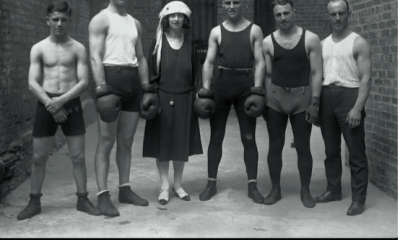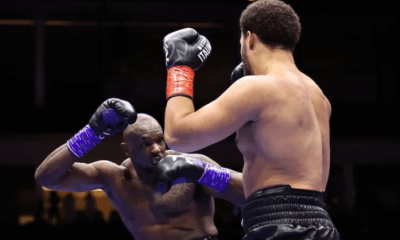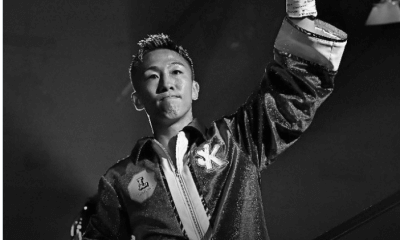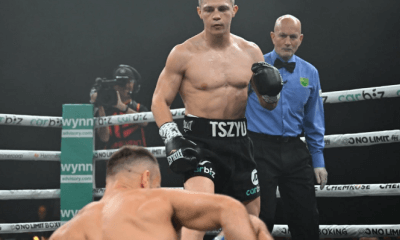Articles of 2005
Boxers and K-1 Grand Prix
Last November 19, Semmy Schilt won the K-1 World Grand Prix tournament held at the Tokyo Dome, in front of 58,213 spectators. The Dutchman also won $400,000. These few lines are enough to understand why professional boxers are so attracted by K-1. Going to Japan means performing in front of a huge crowd, for a major amount of money, knowing that the tournament will be broadcasted all over the world. Who knows? Maybe a strong K-1 performance will bring a good pay check from a promoter in Germany.
First of all, let’s get one thing straight: in this article, I’m referring exclusively to the events promoted by the K-1 Corporation. When you read about a K-1 event held in Europe, it’s organized by the local promoter and it can never be compared to the K-1 Grand Prix events in Japan. The K-1 Corporation is the only company who can offer big purses, huge contracts with major sponsors and turn an unknown athlete into a big star all over the world. That’s because K-1 founder Mr. Ishii understood the reason why the other ring sports (kickboxing, muay thai, savate) never made it to the big time: no money, no job security, no fame. Mr. Ishii made K-1 a profitable business, so everybody wanted to be part of it.
Just think about Peter Aerts, the only fighter who competed in every edition of the K-1 Final Tournament (held once a year, in Tokyo, since 1993). He was muay thai and kickboxing world champion for two different organizations (WMTA and IKBF), but he was getting ridiculous purses (probably, a few thousand U.S. dollars) and was being interviewed only by small ring sports magazines. After he signed with the K-1 Corporation, he became the most famous athlete in Japan, having his photo on newspapers and general magazines and [therefore] getting hired to sponsor several products. Winning the K-1 Grand Prix three times (in 1994, 1995 and 1998) guaranteed him a place in the history of fighting sports and worldwide fame. Today, Peter Aerts is still one of the most acclaimed stars of the K-1 circuit. Even if he looks past his prime, he can still KO anybody.
Including Francois Botha.
The two warriors clashed on December 4, 2004. During the first round, a leg injury forced Aerts to quit. The great battle everybody wanted never occurred. That win was the second of Botha’s career in K-1 competitions. The first one happened on September 25 of that same year: after three rounds, Jerome Le Banner said he couldn’t keep on fighting. Every other Botha fight ended in a loss; once by disqualification, more frequently on points, the last one by KO. What’s more disturbing about the loss against Mighty Mo, is that The White Buffalo got KOed by a series of punches. Everybody knows that K-1 fighters are very good with kicks and knees (the techniques allowed by K-1 rules, besides punches), so a professional boxer should rely on his combinations to get the job done. Mighty Mo knocked down Botha with a right hook, the second time with a right hand, and finished him off with another right hand. The match was held in Las Vegas, where the K-1 organization has a great promoter in Scott Coker.
With a professional boxing record of 44 wins (28 before the limit), 5 losses, 2 draws, 1 no-contest and the title of IBF heavyweight champion, it was reasonable to believe that Francois Botha would have made an impact in K-1 competitions. Nobody could have expected to see him lose seven of nine bouts. What’s the reason of this disaster? Maybe K-1 fighters are that tough? Yes, they are tough. Very tough. But that’s not a good reason for being humiliated by them. Consider what happened to Ray Mercer on March 19, 2005 in Seoul (South Korea): he got KOed in 22 seconds by Remy Bonjaski. In case you don’t know, Bonjaski won the K-1 Grand Prix in 2002 and 2003. He is a real warrior and could hold his own against any of the current heavyweight boxing champions. But, once again, that’s not a reason to lose in a such a one-sided way.
Shannon Briggs, for example, knocked out his opponent in 1 minute and 2 seconds in Saitama, Japan. Of course, Tommy Erickson cannot be compared to a legend like Remy Bonjaski, but he is on the same level as Aziz Khattou (who beat Frans Botha on points). If Briggs could get rid of Erickson, Botha could have done the same with Khattou. So, what’s the problem with boxers entering K-1 competitions? Maybe, they are not motivated anymore. If that’s the case, why did they sign the contract?
That question could be asked of Mike Tyson. He signed to fight in K-1, but all he did was tape a message which was shown during the December 6, 2003 finals, followed by his commentating on the December 31, 2003 card. Tyson spoke via satellite because he couldn’t get a Visa to enter Japan. Mike’s video performances helped him keep his popularity intact in Japan (the attendance of those two shows was 67,320 and 43,560 respectively), but he disappointed those fans who wanted to see him put on the gloves. The former undisputed world heavyweight champion was supposed to fight Bob Sapp. The two men had exchanged big words during a K-1 show held in Las Vegas, but the fight never took place. Even the worst Tyson, say the one we saw against Kevin McBride, could have KOed Sapp. I’ll never forget when Sapp entered the ring like a superstar, with the Japanese crowd adoring him, then got KOed by a Croatian fighter Mirko Filipovic, aka CroCop. The former football player fell to the mat screaming in pain, after only one punch to the nose. Imagine what Mike Tyson would have done to him.
So, let’s get back to the point. Why do professional boxers lose so badly against K-1 fighters? Only they (the pro-boxers) know the answers. I’d like to know what you readers think about it.
Professional boxers fighting in the K-1 Grand Prix. The matches are of 3 rounds of 3 minutes each. If the fight is a draw, one or two extra rounds are allowed. The fighters can use punches, knees and kicks (even to the legs). Elbows are not allowed.
Francois Botha:
October 11, 2003: Loses by DQ against Cyril Abidi.
December 6, 2003: Loses on points against Cyril Abidi.
December 31, 2003: Loses on points to Yusuke Fujimoto.
March 27, 2004: Loses on points to Aziz Khattou.
June 6, 2004: Loses on points to Remy Bonjaski.
September 25, 2004: Wins against Jerome Le Banner, who forfeits after the end of the 3rd round.
December 4, 2004: Defeats Peter Aerts, who quits during the first round claiming a leg injury.
December 4, 2004: Loses on points against Remy Bonjaski.
August, 13 2005: In Las Vegas gets KOed by Mighty Mo during the first round.
Ray Mercer:
March 19, 2005: In Seoul (South Korea) gets KOed in 22 seconds by Remy Bonjaski.
Shannon Briggs:
March 27, 2004: In Saitama (Japan) KOs Tommy Erickson in 1 minute and 2 seconds.
K-1 Grand Prix Finals:
November 19, 2005
Winner: Semmy Schilt (Holland)
Spectators: 58,213
Prize Money: $400,000
December 4, 2004
Winner: Remy Bonjaski (Holland)
Spectators: 64,819
Prize Money: $400,000
December 6, 2003
Winner: Remy Bonjaski (Holland)
Spectators: 67,320
Prize Money: $400,000
December 7, 2002
Winner: Ernesto Hoost (Holland)
Spectators: 74,500
Prize Money: $400,000
December 8, 2001
Winner: Mark Hunt (New Zealand)
Prize Money: $400,000
December 10, 2000
Winner: Ernesto Hoost (Holland)
Spectators: 72,100
December 5, 1999
Winner: Ernesto Hoost (Holland)
December 13, 1998
Winner: Peter Aerts (Holland)
Spectators: 63,800
Prize Money: $230,000
November 9, 1997
Winner: Ernesto Hoost (Holland)
Spectators: 45,000
May 6, 1996
Winner: Andy Hug (Switzerland)
May 4, 1995
Winner: Peter Aerts (Holland)
April 30, 1994
Winner: Peter Aerts (Holland)
April 30, 1993
Winner: Branimir Cicatic (Yugoslavia)
Spectators: 10,000
-

 Featured Articles4 weeks ago
Featured Articles4 weeks agoThe Hauser Report: Cinematic and Literary Notes
-

 Book Review3 weeks ago
Book Review3 weeks agoMark Kriegel’s New Book About Mike Tyson is a Must-Read
-

 Featured Articles2 weeks ago
Featured Articles2 weeks agoThe Hauser Report: Debunking Two Myths and Other Notes
-

 Featured Articles3 weeks ago
Featured Articles3 weeks agoMoses Itauma Continues his Rapid Rise; Steamrolls Dillian Whyte in Riyadh
-

 Featured Articles4 weeks ago
Featured Articles4 weeks agoKotari and Urakawa – Two Fatalities on the Same Card in Japan: Boxing’s Darkest Day
-

 Featured Articles2 weeks ago
Featured Articles2 weeks agoNikita Tszyu and Australia’s Short-Lived Boxing Renaissance
-

 Featured Articles2 weeks ago
Featured Articles2 weeks agoIs Moses Itauma the Next Mike Tyson?
-

 Featured Articles4 weeks ago
Featured Articles4 weeks agoRamirez and Cuello Score KOs in Libya; Fonseca Upsets Oumiha













